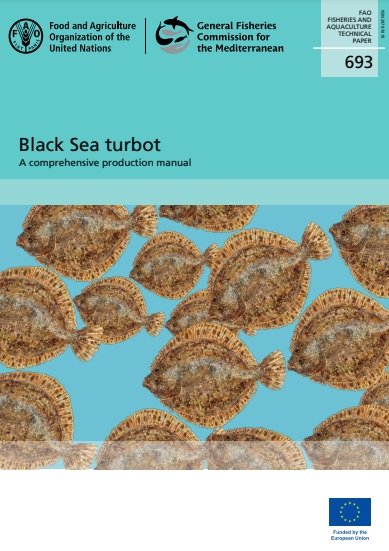
The European aquaculture production of turbot has increased from 40 tons in 1985 to 10,116 tons in 2016. In recent years, in addition to Spain and France, countries such as Chile, China, Denmark, Germany, Iceland, Italy, the Netherlands, Norway, and Portugal have been developing turbot aquaculture.
Currently, the systems and rearing methods for turbot vary among countries and farms. However, turbot aquaculture is mostly conducted in land-based systems.
The General Fisheries Commission for the Mediterranean (GFCM) of the Food and Agriculture Organization of the United Nations (FAO) has published a manual to contribute to the strategy of maximizing technology and information systems in the aquaculture sector by providing detailed information on the entire rearing process of turbot or “black sea turbot” (Scophthalmus maximus).
The turbot farming manual was prepared by experts Ilhan Aydin and Ahmet Faruk Yesilsu, under the coordination of Houssam Hamza, an aquaculture officer at the GFCM.
The document is divided into five sections:
- Introduction to the status of the turbot aquaculture sector, as well as the necessary environmental conditions for optimal production.
- Describes the production of live feed for turbot larvae, starting with microalgae, followed by the production of rotifers and Artemia.
- Details the management of broodstock.
- Procedures for optimal larval rearing.
- Recent biotechnological applications in turbot production: cryopreservation, triploidy, and production of all-female populations.
Turbot production
Turbot require the following parameters for rearing:
| Parameter | Optimal Range |
| Temperature | 16 – 19 oC |
| Salinity | 15.0 – 33.5 ppt |
| Light | 12 hours light: 12 hours darkness |
| Oxygen | 6 – 9 mg/liter |
| Ammonia | <2-3 mg/liter |
Live feed production
The manual provides detailed techniques for the production of live feed (algae, rotifers, and Artemia) to properly feed turbot larvae.
Regarding microalgae, researchers recommend the use of Nannochloropsis oculata and Phaeodactylum tricornutum.
On the other hand, researchers note that only two species of rotifers are used in aquaculture, Brachionus plicatilis (large type) and Brachionus rotundiformis (small type). Small-type rotifers are preferred for the initial feeding of fish larvae due to their small mouths.
Artemia cysts are widely used in turbot aquaculture. Artemia nauplii are used after the rotifer feeding phase.
Management of turbot broodstock
According to the document, it is possible to obtain eggs and sperm for turbot seed production using both wild-caught and hatchery-reared broodstock. However, initially, eggs are collected from wild individuals until the hatchery-reared broodstock mature.
The application of hormones and artificial insemination are essential techniques to ensure effective gamete (eggs and sperm) maturation.
Larval and fingerling production
The manual describes the steps for egg incubation and hatching, as well as the care and feeding of turbot larvae. It also provides optimal stocking densities for different stages.
Additionally, the document includes measures to prevent pathogenic parasites such as nematodes, Trichodina, and Scuticociliata.
Biotechnology applications
While conventional methods of turbot production continue to be used, several biotechnological methods are being implemented, including cryopreservation, triploidy, and all-female populations.
Conclusion
The manual for turbot fingerling production is an informative document for producers of this marine fish, as it provides detailed information on all stages of the production process.
Undoubtedly, studying this document will allow you to enhance your professional skills in turbot rearing.
Reference (open access):
Aydın, I., Küçük, E., Polat, H., Haşimoğlu, A. & Altuntaş, A. 2023. Black Sea turbot – A comprehensive production manual. FAO Fisheries and Aquaculture Technical Paper, No. 693. FAO, Rome. https://doi.org/10.4060/cc6224en

